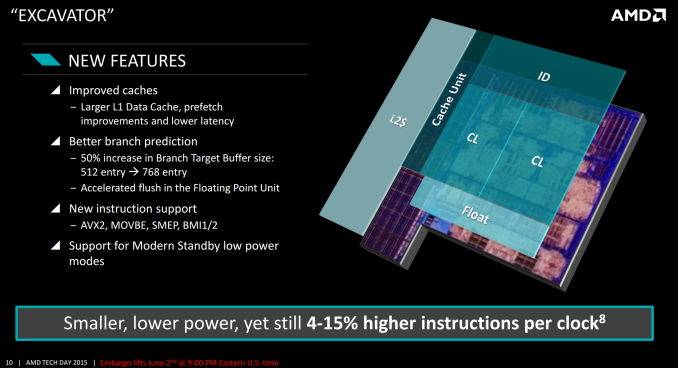AMD Launches Carrizo: The Laptop Leap of Efficiency and Architecture Updates
by Ian Cutress on June 2, 2015 9:00 PM ESTIPC Increases: Double L1 Data Cache, Better Branch Prediction
One of the biggest changes in the design is the increase in the L1 data cache, doubling its size from 64 KB to 128 KB while keeping the same efficiency. This is combined with a better prefetch pipeline and branch prediction to reduce the level of cache misses in the design. The L1 data cache is also now an 8-way associative design, but with the better branch prediction when needed it will only activate the one segment required and when possible power down the rest. This includes removing extra data from 64-bit word constructions. This reduces power consumption by up to 2x, along with better clock gating and minor adjustments. It is worth pointing out that doubling the L1 cache is not always easy – it needs to be close to the branch predictors and prefetch buffers in order to be effective, but it also requires space. By using the high density libraries this was achieved, as well as prioritizing lower level cache. Another element is the latency, which normally has to be increased when a cache increases in size, although AMD did not elaborate into how this was performed.
As listed above, the branch prediction benefits come about through a 50% increase in the BTB size. This allows the buffer to store more historic records of previous interactions, increasing the likelihood of a prefetch if similar work is in motion. If this requires floating point data, the FP port can initiate a quicker flush required to loop data back into the next command. Support for new instructions is not new, though AVX2 is something a number of high end software packages will be interested in using in the future.
These changes, according to AMD, relate to a 4-15% higher IPC for Excavator in Carrizo compared to Steamroller in Kaveri. This is perhaps a little more what we normally would expect from a generational increase (4-8% is more normal), but AMD likes to stress that this comes in addition to lower power consumption and with a reduced die area. As a result, at the same power Carrizo can have both an IPC advantage and a frequency advantage.
As a result, AMD states that for the same power, Cinebench single threaded results will go up 40% and multithreaded results up 55%. The benefits are fewer however the further up the power band you go despite the increase, as the higher density libraries perform slightly worse at higher power than Kaveri.












137 Comments
View All Comments
D. Lister - Wednesday, June 3, 2015 - link
Calling an unlaunched product "bad" would be just as imprudent as calling it "good", but then what do I know, fortune-telling could be just another one of your super powers, along with mind-reading.Gigaplex - Thursday, June 4, 2015 - link
Why would they use an Intel chip to fake a bar graph? Just put fake numbers directly into a spread sheet, job done.Dirty_Punk - Wednesday, June 3, 2015 - link
Unfortunatelly, time to market, as always for AMD, will be probably 6 month or more... at that time there will be something better from intel. It seems a lot like Asus from this point of view, grat product and very bad supply chain.AMD has 3 problems ritght now:
1- with 28nm is difficult to compete against 14nm of intel
2- very slow from project design to mass production
3- no support from OEM and major system builders (HP & co.), as it seems always that Intel works to force system builder to forget about AMD like years ago...
jabber - Wednesday, June 3, 2015 - link
Yep this time next year when you walk into a PC store you'll still see 25 Intel laptops and one cheap nasty AMD laptop on the shelves. OEMs don't care about AMD anymore. From what I see from customers is, that they only buy AMD if they are the cheapest machine in the shop. And then its a E1 chip and the customer really regrets it.haukionkannel - Wednesday, June 3, 2015 - link
That problem 1 is the worst! AMD APUs are ok, but 28nm vs Intel 14nm is just a huge deal. When considering power and efficiency and how much they can put on the chip.jimjamjamie - Wednesday, June 3, 2015 - link
HP is actually pretty good for offering a good selection of AMD-powered laptops, usually the cheaper models. Better than most other OEMs though.bloodypulp - Wednesday, June 3, 2015 - link
The only decent laptops HP makes are the Elitebooks. And you will pay through the nose for them when you can get better quality from other brands for less. HP should just stop making PCs, period.UtilityMax - Wednesday, June 3, 2015 - link
HP has several models with AMD chips. It's one of them few laptop makers that allows you to configure an Envy laptop with say a 1080p screen, SSD, a A10 CPU, plus discrete graphics.jabber - Thursday, June 4, 2015 - link
And I bet they sell about 8 of those AMD based machines a year.watzupken - Thursday, June 11, 2015 - link
Point 2 is probably their killer to be honest. Point 1 is definitely puts AMD in a disadvantage, but considering that Intel don't seem to be interested in pushing performance since its Sandy Bridge days, it's giving AMD a chance to catch up in terms of performance.To be honest, I think I have to take my hat off AMD's efforts. At 28nm, they are forced to be as creative as they can to squeeze performance out, while keeping power requirements in check.